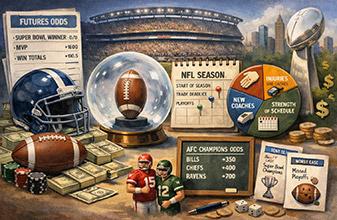Sportsbooks refusing “sharp” parlay cards

King Yao is the author of Weighing the Odds in Hold‘em Poker, and Weighing the Odds in Sports Betting. He uses his experience in financial derivative markets and translates it into gambling. Since he left his trading position in 2000, he has been playing poker and betting on sports. He is in Las Vegas frequently, especially during football season.
Prospective sports bettors should know the basic principles of sports betting. You should not be betting online or anywhere else without this fundamental knowledge.
Casinos make adjustments, especially after suffering heavy losses. In the case of parlay cards, casinos keep an eye on games where the line has moved. When a line moves enough, the game may be taken off the parlay cards.
For smaller line changes, the sportsbooks may leave the games alone. But if you try to bet large on parlay cards, the sportsbook may refuse the wager. Unlike the limits on normal games, $500 is considered a large amount on parlay cards at most sportsbooks. Clerks often have to get approval from supervisors in order to print tickets of that value on parlay cards. The supervisor will look to see which games you picked. Smart (but nasty) supervisors will accept parlay cards filled with square bets, but refuse parlay cards filled with sharp bets. The squares get their negative-EV bets accepted while the sharps get their positive-EV bets rejected.
It is work to bet parlay cards profitably for a large amount of money. Due to the low dollar amount that most sportsbooks accept in sharp action on parlay cards, you make small wagers. In order to bet a large amount, you make bets at many sportsbooks. That involves a lot of driving and walking around Las Vegas or Reno.
Push Percentages
Using data from NFL games over 15 years, I calculated the approximate push percentage for each point spread. I used games lined within one of the point spread; that is, I used games that were at most one point higher and one point lower than the “Line.” Then I counted the number of pushes in those games, assuming the line was the same as the point spread in all of the games for that subset. I also calculated the value of a half-point, in cents.
For example, with a point spread of the home team as a +7 underdog, I looked at all 266 games where the home team was an underdog from +6 to +8. In 6.8% of those games the home team lost by exactly 7. The standard error on that 6.8% is 1.5%, so plus and minus one standard error is 5.3% to 8.3%. The value for the half point for that line is 15 cents with a standard error of 3 cents.
The numbers are based on small sample sizes, as are most numbers generated from NFL games since each team only plays 16 games a year. You may feel more comfortable smoothing out the numbers. For example, it does not make much sense that the push percentage for +1 is 1.4% while for -1 it is 2.9%. A reasonable adjustment might be to change +1 to 2.0% and -1 to 2.3%.
Local Parlay Cards
One Friday night while 2,000 miles from Nevada, I noticed a parlay card on the counter of a restaurant. Apparently the card was printed by a local bookmaker. It shocked me to see how bad the payoffs were:
- 4 Teams: 9 to 1
- 5 Teams: 15 to 1
- 6 Teams: 25 to 1
Fair odds assuming a 50% win rate per game should be:
- 4 Teams: 15 to 1
- 5 Teams: 31 to 1
- 6 Teams: 63 to 1
In order for their payouts to be fair value, one would need to have the following average win rate for each game in the parlay:
- 4 Teams: 56.2%
- 5 Teams: 57.4%
- 6 Teams: 58.1%
It was actually worse than that, as the parlay card specified ties lose, and all the games had point spreads as whole numbers. None of the lines on the card were half-point lines. Any game that landed on the number would be an automatic loser for both sides. For example, when the printed line is 3, the bookmaker is in effect dealing a line of -3.5 to the players taking the favorite and +2.5 to the players taking the underdog. As bad as the sportsbooks in Las Vegas can be to their customers, local bookmakers may be even worse, as this parlay card shows. Bettor beware!
This is part of an occasional series of articles.
Excerpted with permission from the e-book version of Weighing the Odds in Sports Betting by King Yao, edited for this format.











Please log in or register to leave a comment